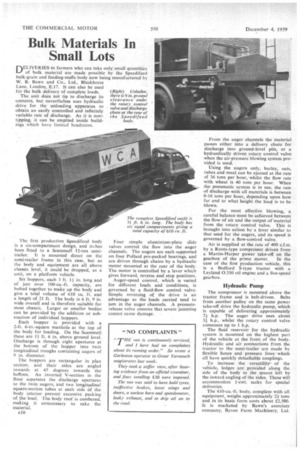Bulk Materials In Small Lots
Page 54

If you've noticed an error in this article please click here to report it so we can fix it.
• DELIVERIES to farmers who can take only small quantities
The unit does not tip to discharge its contents, but nevertheless uses hydraulic drive for the unloading apparatus to obtain an easily controlled and infinitely variable rate of discharge. As it is nontipping, it can be emptied inside buildings which have limited headroom.
The first production Speedifeed body is a six-compartment design, and itahas been fitted to a Scammell 12-ton semitrailer. It is mounted direct on the semi-trailer frame in this case, but as the body and equipment are all above chassis level, it could be dropped, as a unit, on a platform vehicle.
Six hoppers, each 3 ft. 1+ in. long and of just over 100-cu.-ft. capacity, are bolted together to make up the body and give a total volume of 610 cu. ft. and a length of 21 ft. The body is 6 ft. 9 in. wide overall and is therefore suitable for Most chassis. Larger or smaller bodies can be provided by the addition or subtraction of individual hoppers.
Each hopper is provided with a 2-ft. 6-in.-square manhole at the top of the body for loading. On the Scammell these are 11 ft. 6 in. above ground level. Discharge is through eight apertures at the bottom of the hopper into twin longitudinal troughs containing augers of 9 in. diameter.
The hoppers are rectangular in plan section, and their sides are angled inwards at 45 degrees towards the bottom. An inverted V-section in the floor separates the discharge apertures to the twin augers, and two longitudinal square-section tubes at each side of the body interior prevent excessive packing of the load. The body roof is cambered. making it unnecessary to rake the material.
E 1 0 Four simple aluminium-plate slide valves control the flow into the auger channels. The augers are each supported on four Pollard pre-packed bearings, and are driven through chains by a hydraulic motor mounted at the rear of the body. The motor is controlled by a lever which gives forward, reverse and stop positions.
Auger-speed control, which is varied for different loads and conditions, is governed by a fluid-flow control valve. Simple reversing of the drive is an advantage as the loads carried tend to jam in the auger channels. A pressurerelease valve ensures that severe jamming cannot cause damage. From the auger channels the material passes either into a delivery chute for discharge into ground-level pits, or a hydraulically driven rotary control valve when the air-pressure blowing system provided is used.
Using the augers only, barley, oats, cubes and meal can be ejected at the rate of 36 tons per hour, whilst the flow rate with wheat is 40 tons per hour. When the pneumatic system is in use, the rate of discharge with all materials is between 8-16 tons per hour, depending upon how far and to what height the load is to be blown.
For the most effective blowing, a careful balance must be achieved between the flow of air and the output of 'material from the rotary control valve. This is brought into action by a lever similar to that used for the augers, and its speed is governed by a flow-control valve.
Air is supplied at the rate of 400 c.f.m. by a Roots-type compressor driven from a Martin-Harper power take-off on the
gearbox of the prime mover. In the case of the first production vehicle, this is a Bedford S-type tractor with a Leyland 0.350 oil engine and a five-speed gearbox.
Hydraulic Pump
The compressor is mounted above the tractor frame and is belt-driven. .Belts from another pulley on the same power take-off drive the hydraulic pump, which is capable of delivering approximately 71 h.p. The auger drive uses about 31 h.p., whilst the rotary control valve consumes up to 1 h.p.
The fluid reservoir for the hydraulic system is .mounted on the highest part of the vehicle at the front of the body. Hydraulic and air connections from the tractor* to the semi-trailer are made by flexible hoses and pressure lines which all have quickly detachable couplings.
To increase the versatility. of the vehicle, ledges are. provided along the side of the body in the spaces left by the inward angling of the sides. These will accommodate 1-cwt. sacks for special deliveries.
The 610-cu.-ft. body, complete with all equipment, weighs approximately 2+ tons and in its basic form costs about £2,500. It is marketed. by Bawn's associate company, Byron Farm Machinery, Ltd.
























































































































